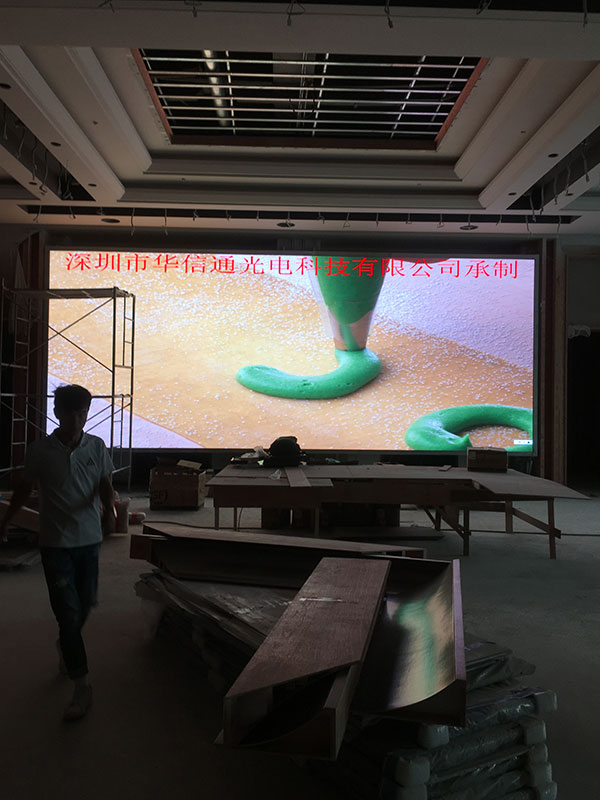With the increasing use of LED electronic screens, high-definition LED displays can be seen everywhere. However, some screens may exhibit stripes or fail to display image details when viewed or captured with high-definition cameras, and the grayscale level and refresh rate of these screens are related. So, what is the relationship between the grayscale level and refresh rate of LED electronic screens? Below is a brief introduction from the manufacturer of Huaxintong Optoelectronics LED display screens.

Gray scale
The grayscale level of LED electronic screens refers to the variation of various colors between peak dark and peak bright colors, with different color levels. The grayscale level of traditional high-definition LED displays is generally between 14 bits and 16 bits, with 16384 color levels or more, which can display more detailed changes in image colors. If the grayscale level is not sufficient, there may be insufficient color hierarchy or gradient color levels that are not smooth enough, and the color of the image that appears during playback may not be fully displayed. To a large extent, the display effect of LED screens is reduced. If the image captured with a 1/500s shutter has obvious color blocks, it indicates that the grayscale level of this screen is low. If a higher shutter speed is used, such as 1/1000s or 1/2000s, more prominent color blocks will be seen, seriously affecting the overall visual appeal of the image.
refresh frequency
The refresh rate refers to the rate at which the screen is updated, measured in Hz. The refresh rate of traditional LED electronic large screens is around 720Hz-1920Hz, while the refresh rate of small pitch LED displays is around 3000Hz-3840Hz, or even higher. The higher the refresh rate, the high-definition and delicate the played image, the more stable the display, and the less flickering the video feels. Generally speaking, for conventional high-definition LED displays, if not viewed up close, a refresh rate of around 1920Hz can meet user needs. However, for LED rental screens used for live streaming, stage design performances, and large-scale events that require close viewing, a refresh rate of 1920Hz clearly cannot meet the requirements for high-definition image quality.
Therefore, in the field of stage design and large-scale events such as live streaming, the required refresh rate for LED rental screens and small pitch LED displays is around 3840Hz. It can meet the requirement that there will be no stripes or flickering during high-definition camera shooting. If the refresh rate is relatively low, horizontal stripes are prone to appear during shooting, and there may also be flickering, which can even cause visual fatigue and harm to the human eye when viewed for a long time.
What is the relationship between refresh rate and grayscale level
The refresh frequency and grayscale level of high-definition LED displays are related to the LED driver chip. The higher the refresh and grayscale of the driver chip, the higher the refresh and grayscale of the screen. Therefore, in order to ensure higher refresh and grayscale of the screen, Huaxintong Optoelectronics LED display manufacturers generally choose ScrambledPWM, also known as S-PWM technology. S-PWM technology improves the traditional pulse width modulation technique by dispersing the conduction time of an image into several shorter conduction times, thereby increasing the overall visual update rate, that is, the refresh rate.
The new generation of LED driver chips will be equipped with S-PMW technology, which can break down the original counting method of once per frame (LED chip ON LED chip OFF) into multiple counts on average, and each broken fraction can maintain the original On/Off ratio before breaking down. While increasing the overall refresh rate of LED displays, it does not affect the performance and stability of the screen.
Due to the fact that S-PWM technology not only provides different counting modes, but also increases the refresh rate of images by 64 times. If ordinary driver ICs are replaced with S-PWM technology, the refresh rate of the image can be invisibly increased, and only a low order clock (5MHz) is needed to increase the refresh rate by 64 times, with a refresh rate of over 4800Hz. Moreover, the refresh rate of conventional LED electronic screens is increased by more than 10 times, which can also avoid problems such as high-frequency electromagnetic interference, overvoltage surges, and undervoltage surges.
Due to the use of S-PWM driver chips, the refresh rate of high-definition LED displays can be increased to over 4800Hz, so there will be no horizontal black scanning lines or color block distribution when shooting with high-definition cameras. And both the refresh rate and grayscale level are much higher than ordinary switch type driver chips. Therefore, the small pitch LED displays used by LED display manufacturers will use S-PWM driver chips to improve the refresh rate and grayscale level of the screen.